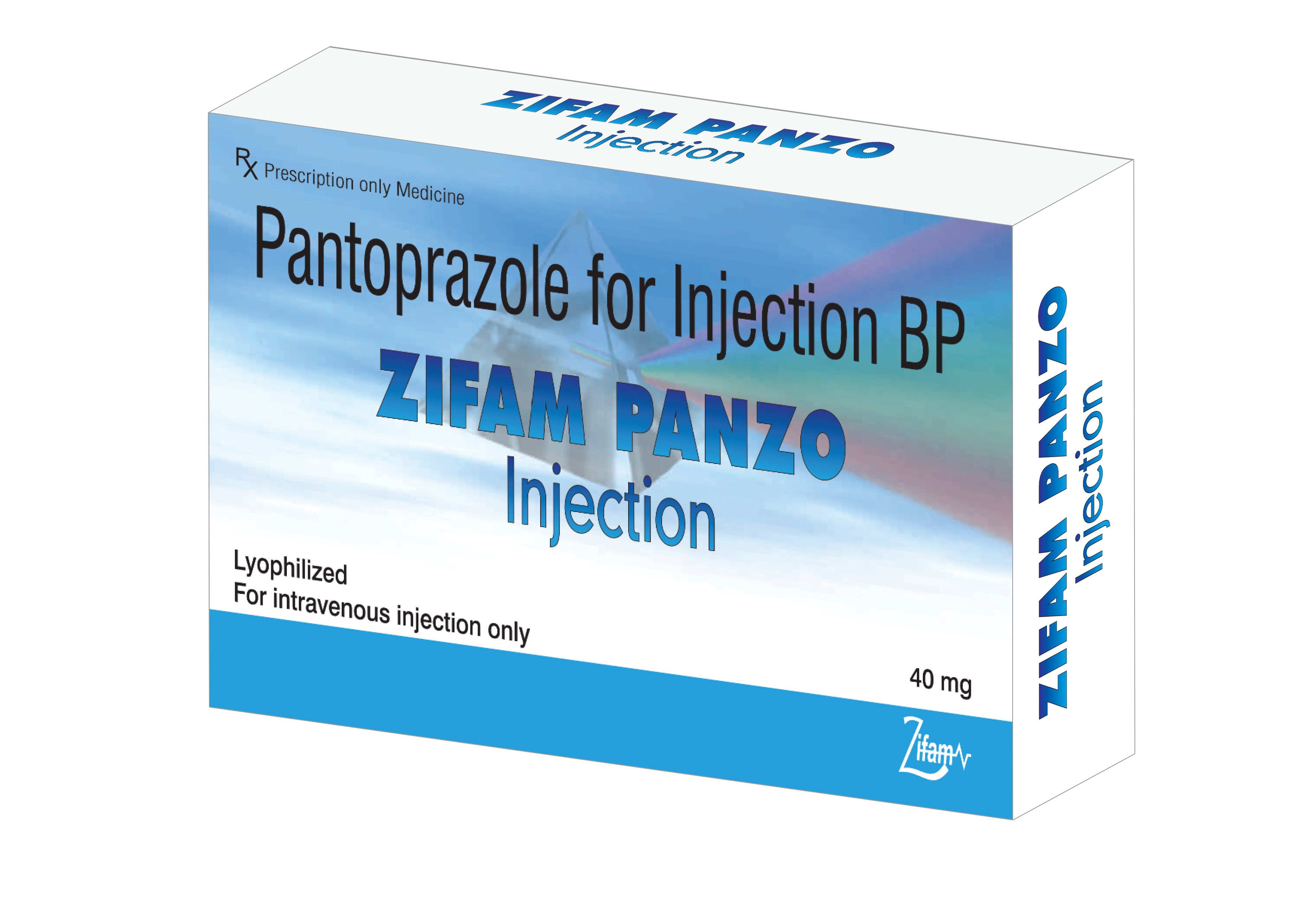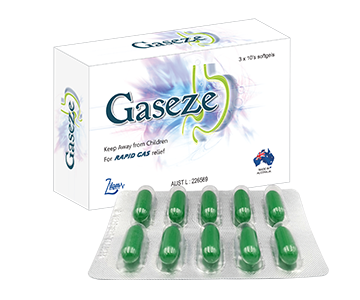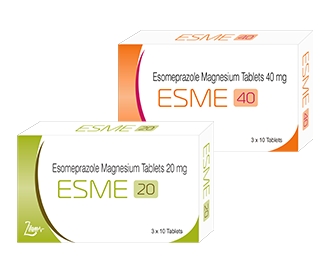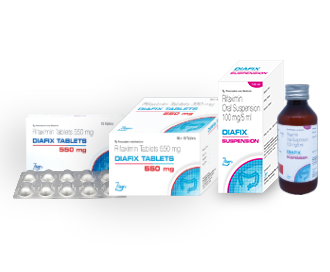Zifam Novocid 10 / 20
- ENG
- မြန်မာ
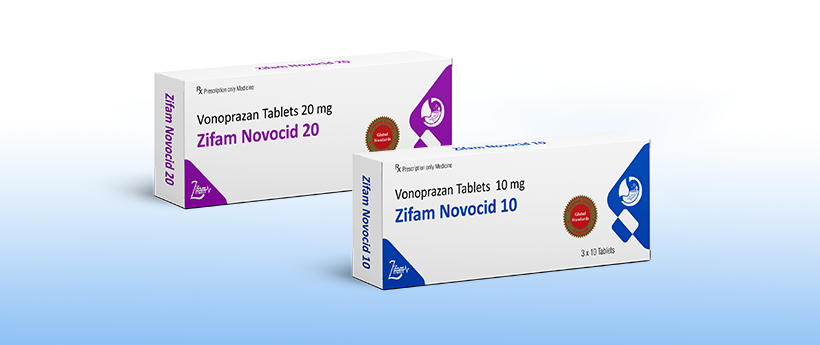
For the use of Registered Medical Practitioner or a Hospital or Laboratory
Zifam Novocid 10
Vonoprazan Tablets 10 mg
COMPOSITION
Each film-coated tablet contains:
Vonoprazan Fumarate
Equivalent to Vonoprazan ……………. 10 mg
Zifam Novocid 20
Vonoprazan Tablets 20 mg
COMPOSITION
Each film-coated tablet contains:
Vonoprazan Fumarate
Equivalent to Vonoprazan …………… 20 mg
CLINICAL PARTICULARS
Therapeutic Indications
Vonoprazan is indicated for:
1. Gastric ulcer, duodenal ulcer, reflux esophagitis, prevention of recurrence of gastric or duodenal ulcer during low-dose aspirin administration, prevention of recurrence of gastric or duodenal ulcer during non-steroidal anti-inflammatory drug (NSAID) administration.
2. Adjunct to Helicobacter pylori eradication in the following settings:
Gastric ulcer, duodenal ulcer, gastric mucosa-associated lymphatic tissue (MALT) lymphoma, idiopathic thrombocytopenic purpura, the stomach after endoscopic resection of early stage gastric cancer or Helicobacter pylori gastritis.
DOSAGE AND ADMINISTRATION
Gastric ulcer and duodenal ulcer
The usual adult dosage for oral use is 20mg of Vonoprazan administered orally once daily an 8 weeks treatment for gastric ulcer and a 6 weeks treatment for duodenal ulcer.
Reflux esophagitis
The usual adult dose for oral use is 20mg of Vonoprazan administered once daily for a total of 4 weeks of treatment. If that dosing proves insufficient, the administration should be extended, but for no longer than 8 weeks of treatment.
For the maintenance therapy of reflux esophagitis showing recurrence an d recrudescence, the dose for oral use is 10mg of Vonoprazan once daily.
However, when the efficacy is inadequate, the dosage may be increased up to 20mg of Vonoprazan once daily.
Prevention of recurrence of gastric or duodenal ulcer during low-dose aspirin administration
The usual adult dosage is one tablet of 10mg of Vonoprazan administered orally once daily.
Prevention of recurrence of gastric or duodenal ulcer during non-steroidal anti- inflammatory drug (NSAID) administration.
The usual adult dosage is one tablet of 10mg of Vonoprazan administered orally once daily.
Adjunct to Helicobacter pylori eradication
For adults, the following three-drug regimen should be administered orally at the same time twice daily for seven days: 20mg of Vonoprazan, 750mg of amoxicillin and 200mg of clarithromycin. The dose of clarithromycin may be increased as clinically warranted. However, dosage should not exceed 400mg twice daily.
If Helicobacter pylori eradication with a three- drug regimen comprising a proton pump inhibitor, amoxicillin and clarithromycin has been unsuccessful , as an alternative treatment, adults should be administered the following three drugs orally twice daily for seven days: 20mg of Vonoprazan, 750mg of amoxicillin and 250mg of metronidazole.
CLINICAL PHARMACOLOGY
Mechanism of Action
Vonoprazan is a potassium competitive acid blocker (P-CAB) and does not require activation by acid. It inhibits H+, K+/-ATPase in a reversible and potassium-competitive manner. Vonoprazan has a strong basicity and resides on the acid production site of gastric parietal cells for a long time, thereby inhibiting gastric acid production.
Vonoprazan exerts a strong inhibitory effect on formation of mucosal damage in upper part of the gastrointestinal tract. Vonoprazan does not exhibit anti-Helicobacter pylori activity nor inhibitory activity against Helicobacter pylori urease.
Adjunctive effect on eradication of Helicobacter pylori:
The role of Vonoprazan in the Helicobacter pylori eradication is considered to increase intragastric pH leading to the enhancement of antibacterial activity of amoxicillin, clarithromycin and metronidazole which are concomitantly administered.
Pharmacokinetics
Pharmacokinetics at consecutive administration of a daily dose of 10mg or 20mg of Vonoprazan in healthy adult male subjects once daily for 7 days, AUC (0-tau) and Cmax increase as the dose increases. The degree of these increases is slightly higher than the dose ratio. It is considered that the steady state has been reached by day 3 of administration, since the trough level of the blood concentration of Vonoprazan is constant between day 3 and day 7 of administration. In addition, it is considered that pharmacokinetics of Vonoprazan at consecutive administration may not be time- dependent, as the result of the evaluation of accumulation with regard to AUC (0-tau) and T1/2 of Vonoprazan.
| Dose condition | 10 mg | 20 mg |
| Tmax (h) | 1.5 (0.75, 3.0) | 1.5 (0.75, 3.0) |
| Cmax (ng/ml) | 12.0 +/- 1.8 | 26.3 +/- 6.6 |
| T1/2 (h) | 7.0 +/- 1.6 | 6.1 +/- 1.2 |
| AUC(0-tau) (ng.h/ml) | 79.5 +/- 16.1 | 151.6 +/- 40.3 |
|
Mean +/- S.D. of 9 subjects \ [Tmax is expressed by the median (minimum value, maximum value)] |
||
Absorption
Absolute bioavailability has not been determined. The pharmacokinetic parameters of Vonoprazan following single administration of Vonoprazan to healthy adult male subjects at 20mg under fasting and fed conditions are presented in the table as follows:
| Dose condition | Under fasting | After meal |
| Tmax (h) | 1.5 (0.75, 3.o) | 3.o (1.0, 4.0) |
| Cmax (ng/ml) | 24.3 +/- 6.6 | 26.8 +/- 9.6 |
| T1/2 (h) | 7.7 +/- 1.0 | 7.7 +/- 1.2 |
| AUC(O-tau) (ng.h/ml) | 222.1 +/- 69.7 | 238.3 +/- 71.1 |
|
Mean +/- S.D. of 9 subjects [Tmax is expressed by the median (minimum value, maximum value)] |
||
Distribution
The protein binding rate is 85.2 to 88.0% when [14C] Vonoprazan in the range of 0.1 to 10ug/mL is added to human plasma (in vitro).
Metabolism
Vonoprazan is metabolized mainly by hepatic drug-metabolizing enzyme CYP3A4 and partially by CYP2B6, CYP2C19 and CYP2D6. Vonoprazan is also metabolized by sulfotransferase SULT2A1 (in vitro).
Vonoprazan exhibits time -dependent inhibitory effect on CYP2B6, CYP2C19 and CYP3A4/5 (in vitro). In addition, Vonoprazan shows a slight concentration-dependent inductive effect on CYP1A2 but it shows little inductive effect on CYP2B6 and CYP3A4/5 (in vitro).
Elimination
When radioactive-labelled drug (as Vonoprazan) is orally administered to healthy adult male subjects, 98.5 % of the radioactivity administered is excreted into urine an d feces by 168 hours after administration: 67.4% into urine and 31.1% into feces.
Special population
Patients with renal impairment
The effect of renal disorders on pharmacokinetics of Vonoprazan in subjects with normal renal function, patients with mild, moderate, and severe renal disorder and patients with end-stage renal disease (ESRD) when administered the drug as a single dose of Vonoprazan 20mg shows that AUC@ and Cmax were higher by 1.3 to 2.4 times and 1.2 to 1.8 times, respectively, in patients with mild, moderate, and severe renal disorder compared to subjects with normal renal function, showing an increase with a reduction in renal function. AUC@ and Cmax were higher by 1.3 times and 1.2 times, respectively, in ESRD patients compared to those in subjects with normal renal function.
Patients with hepatic impairment
The effect of hepatic disorders on pharmacokinetics in subjects with normal hepatic function and patients with mild, moderate and severe hepatic disorder when administered the drug as a single dose of Vonoprazan 20mg shows that AUC@ and Cmax were higher by 1.2 to 2.6 times and 1.2 to 1.8 times, respectively, in patients with mild, moderate and severe hepatic disorder, compared to subjects with normal hepatic function.
CONTRAINDICATIONS
Vonoprazan is contraindicated in:
- Patients with hypersensitivity to Vonoprazan or to any excipient of the product.
- Patients receiving atazanavir sulphate
WARNINGS AND PRECAUTIONS
General
At the treatment the course of the disease should closely be observed and the minimum therapeutic necessity should be used according to the disease condition.
In the long-term treatment with Vonoprazan, close observation by such means as endoscopy should be made.
In the maintenance of healing of reflux esophagitis, Vonoprazan should be administered only to the patients who repeat recurrence and recrudescence of the condition.
Administration to the patients who do not necessitate maintenance of healing should be avoided.
When the healing is maintained over a long period and when there is no risk of recurrence, the dose reduction to a dose of 10mg from a dose 20mg, or suspension of administration should be considered.
Impaired Renal Function
Vonoprazan should be administered with care in patients with renal disorders as a delay in the excretion of Vonoprazan may occur, which may result in an increase in the concentration of Vonoprazan in the blood.
Impaired Hepatic Function
Vonoprazan should be administered with care in patients with hepatic disorders as a delay in the metabolism and excretion of Vonoprazan may occur, which may result in an increase in the concentration of Vonoprazan in the blood. Hepatic function abnormalities including liver injury have been reported. Discontinuation of Vonoprazan is recommended in patients who have evidence of liver function abnormalities or if they develop signs or symptoms suggestive of liver dysfunction.
Administration of Vonoprazan results in elevation of intragastric pH and is therefore not recommended to be taken with drugs for which absorption is dependent on acidic intragastric pH. Symptomatic response to Vonoprazan does not preclude the presence of gastric malignancy. It is therefore, necessary to ascertain the ulcer is not of a malignant nature before initiating the administration of this drug.
Clostridium difficile, serious colitis, including pseudomembranous colitis.
There is an increased risk of gastrointestinal infection caused by Clostridium difficile.
Serious colitis accompanied with bloody stools, such as pseudomembranous colitis, may occur due to amoxicillin hydrate or clarithromycin being used for Helicobacter pylori eradication, in combination with Vonoprazan. If abdominal pain and frequent diarrhea occur, appropriate measures, such as immediate discontinuation of the treatment, should be taken.
Benign gastric polyps
Benign gastric polyp has been observed in patient on long-term administration of PPIs.
Fractures
An increased risk for osteoporosis-related fractures of the hip, wrist or spine have been reported in patients under treatment with proton pump inhibitors. The risk of fracture was especially increased in the patients receiving high dose or long term (a year or longer) treatment.
Hypomagnesemia
Severe hypomagnesemia has been reported in patients on prolonged treatment with PPIs for at least three months and in most cases for a year.
Use in elderly
Since the physiological functions such as hepatic or renal function are decreased in elderly patients in general, Vonoprazan should be carefully administered.
Use in children less than 18 years of age Vonoprazan has not been studied in patients under 18 years of age.
Pregnancy
Vonoprazan should be used in pregnant women or women having possibilities of being pregnant only if the expected therapeutic benefit is thought to outweigh any possible risk.
Nursing Mothers
It is advisable to avoid the administration of Vonoprazan to nursing mothers. However, when the administration is indispensable, nursing should be discontinued.
ADVERSE REACTIONS
Following adverse reactions have been reported with the use of Vonoprazan: Diarrhea, constipation, drug hypersensitivity (including an aphylactic shock), drug eruption, urticaria, hepatotoxicity, jaundice, rash, nausea, abdominal distension, gamma-glutamyl transferase increased, AST increased, Liver function test abnormal, ALT increased, ALP increased, LDH increased, GPT increased, edema and eosinophilia.
DRUG INTERACTIONS
Vonoprazan should be administered with care when co-administered with the following drugs:
| Drugs | Signs | Mechanism & Risk Factors |
|
CYP3A4 inhibitors Clarithromycin etc. |
Blood conc. of Vonopaan may inrease. | It has been reported that blood conc. of Vonoprazan increased in concomitant use with clarithromycin. |
| Digoxin, Methyldigoxin |
Effect of these drugs may be enhanced. |
Gastric antisecretory effect of Vonoprazan may inhibit hydrolysis of digoxin, resulting in increase in the blood concentration of digoxin. |
|
Itraconazole, Tyrosine kinase inhibitors Gefitinib, Nilotinib, Erlotinib |
Effect of these drugs may be diminished. | Gastric antisecretory effect of Vonoprazan may lead to a decrease in the blood concentration of these drugs. |
OVERDOSE
There is no experience of overdose with Vonoprazan. Vonoprazan is not removed from the circulation by hemodialysis. If overdose occurs, treatment should be symptomatic and supportive.
STORAGE
Store below 30°C and protect from light.
PRESENTATION
Alu-Alu blister pack of 3 x 10’s in a carton box along with pack insert.
KEEP MEDICINE OUT OF REACH OF CHILDREN.







